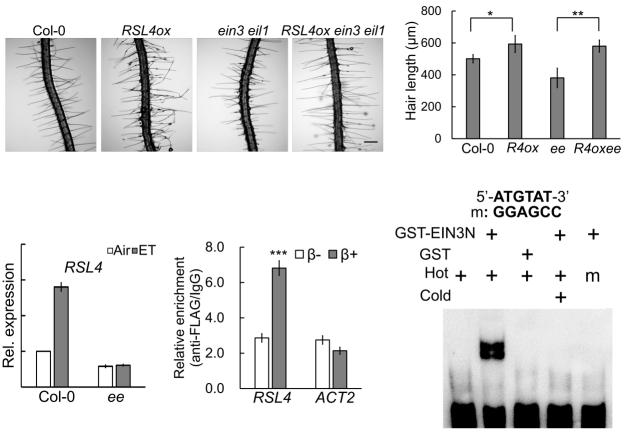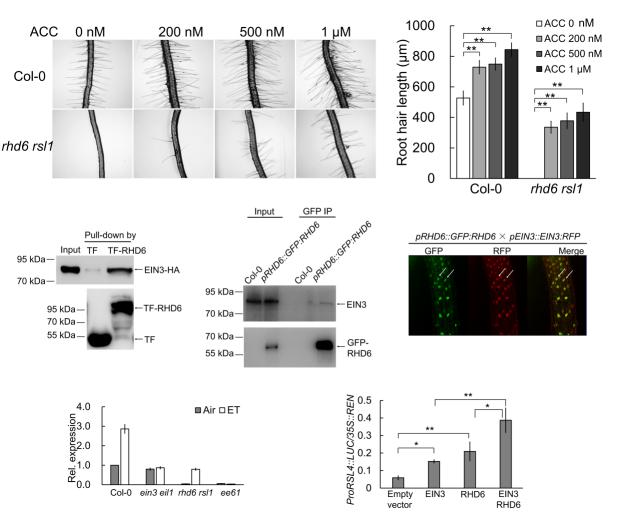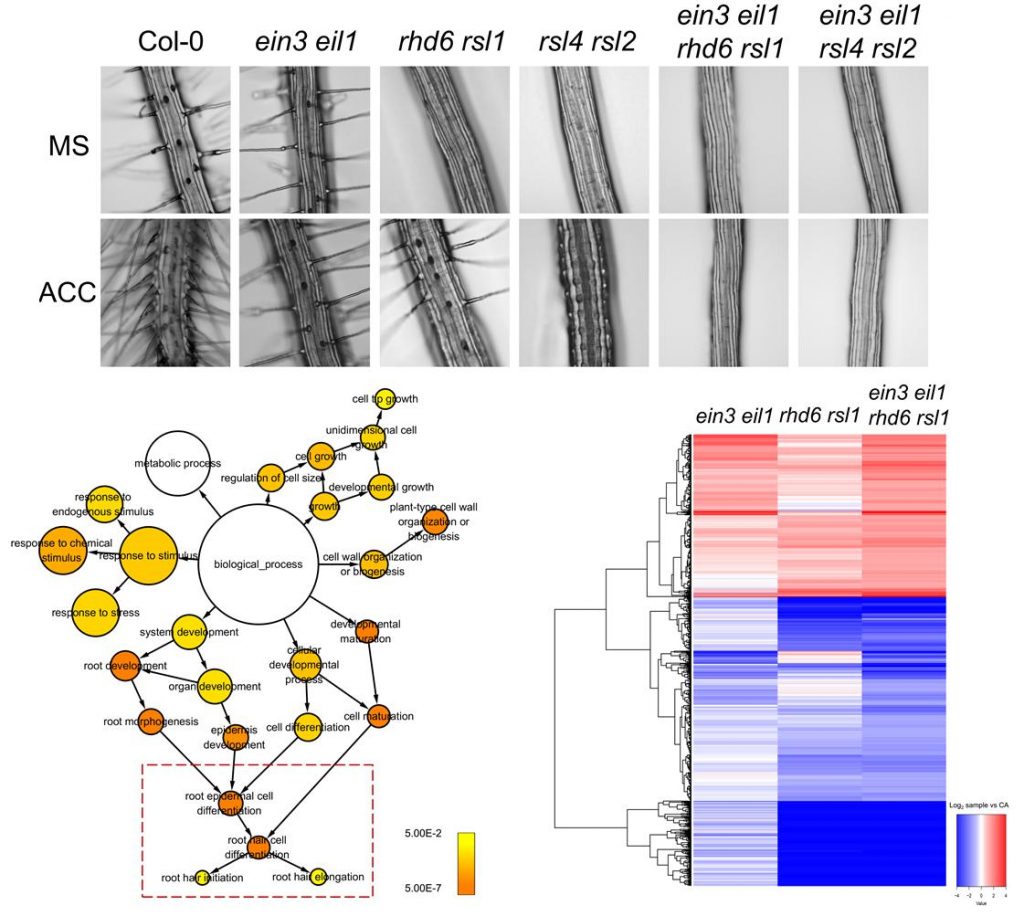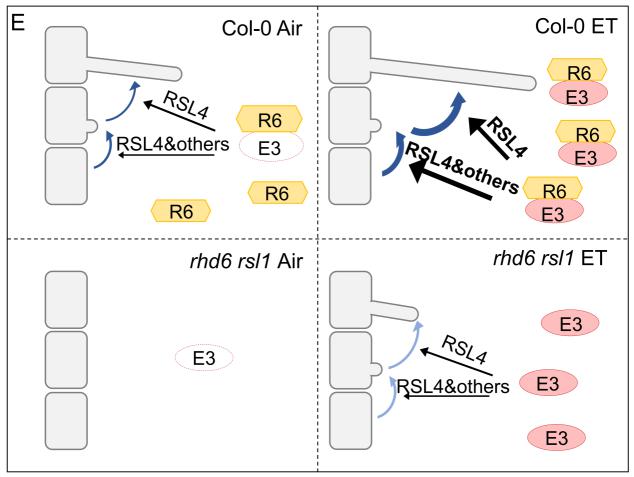Root hairs are an extensive structure of root epidermal cells and are critical for nutrient acquisition, soil anchorage and environmental interactions in sessile plants. The morphogenesis of root hairs responds to diverse environmental challenges rapidly and effectively, thus root hairs are an excellent model system for studying endogenous and exogenous signals integration in plants. The plant hormone ethylene has been reported to play a vital role in promoting root hair growth and in mediating other hair-stimulating signals for decays. However, the underlying molecular basis remains poorly understood.
The team of Dr. Hongwei Guo, from Department of Biology at SUSTech, is one of the global leading groups in the research field of ethylene signaling. In the past 15 years, the Guolab has made significant contributions to illustrate the molecular mechanisms of ethylene signal transduction. Their breakthrough findings include the post-translational regulation of master transcription factors by EBF1/2-mediated protein degradation (Cell, 2003; Plant Cell, 2010), the “cleave and shutter” model of EIN2 in relaying signal from ER to nucleus (Cell Research, 2012), and the 3’UTR -mediated translational regulation(PNAS, 2006;Cell, 2015). Furthermore, the Guolab has also been focusing on exploring the molecular and genetic mechanisms underlying ethylene regulated plant organ development, including root growth (Plant Cell, 2011), apical hook formation (Cell Research 2012; Plant Cell, 2014), and leave senescence (Plant Cell, 2013; 2017). The latest finding from the Guolab published online on PNAS revealed the molecular mechanism of ethylene-promoted root hair growth in Arabidopsis. This finding extended our understanding of the physiological function of ethylene, and provided new theoretical basis for molecular breeding in improving crop yield traits, for example in increasing nutrition acquisition ability.
By molecular genetic analysis, Feng et al. first demonstrated that ethylene promotes root hair elongation through directly increasing the expressing level of the hair-length-determining gene, RSL4, by the two master transcriptional factors EIN3/EIL1 (Figure 1).

Fig 1. RSL4, the master regulator of root hair elongation, is a direct target of EIN3.
Next, Feng et al. found that the effect of ethylene on root hair elongation is largely dependent on the function of two well-documented positive regulators of hair cells, RHD6/RSL1. Through in vitro and in vivo protein interaction assays and subcellular co-localization analysis, Feng et al. demonstrated that EIN3 physically interacts with RHD6, and the two factors directly co-activate RSL4 gene to promote root hair elongation (Figure 2). Since RHD6/RSL1 are two atypical transcriptional factors with unclear DNA binding ability, the coordinate activity of EIN3/EIL1-RHD6/RSL1 protein complex indicates a potential working mode of RHD6/RSL1.

Fig 2. EIN3/EIL1 coordinate with RHD6/RSL1 to upregulate RSL4.
To further explore the regulatory role of EIN3/EIL1-RHD6/RSL1 in a genome-wide view, Feng et al. constructed and then analyzed the root transcriptome profiles of different mutants in response to ethylene. A set of root hair initiation and elongation promoting genes were identified to be co-activated by EIN3/EIL1 and RHD6/RSL1 (Figure 3). Consistently, phenotypic analysis of different mutants also revealed the essential role of EIN3/EIL1 and RHD6/RSL1. The ein3eil1 rhd6rsl1 quadruple mutant, but not either double mutants, was insensitive to several hair stimuli including application of auxin or cytokinin and depletion of phosphorus or nitrogen. Taken together, these findings uncovers the molecular mechanism of ethylene-promoted root hair growth and identifies a transcriptional complex as the key regulator of root hair initiation and elongation. As ethylene mediates the effects of various root hair stimuli, this work also elucidates a convergent signaling network that integrates diverse environmental cues and intrinsic signals to modulate plant organ development (Figure 4).

Fig 3. EIN3/EIL1 and RHD6/RSL1 co-regulate both hair initiation and elongation genes.

Fig 4. Molecular mechanism underlying ethylene-promoted root hair development through coordinated EIN3/EIL1 and RHD6/RSL1 activity in Arabidopsis.
A former visiting scholar Dr. Ying Feng at Department of Biology is the first author for this article, and chair professor Hongwei Guo and senior research associate Dr. Yichuan Wang are the authors of the communication. The study was supported by the National Natural Science Foundation of China, Peking University – Tsinghua Life Science Joint Center and Start-up Funding from SUSTech.
This work is open accessible at: http://www.pnas.org/content/early/2017/12/11/1711723115
Proofread By
Photo By